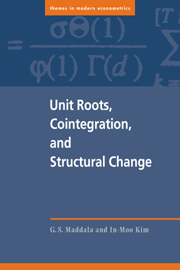Book contents
- Frontmatter
- Contents
- Figures
- Tables
- Dedication
- Preface
- Part I Introduction and basic concepts
- Part II Unit roots and cointegration
- Part III Extensions of the basic model
- 8 The Bayesian analysis of stochastic trends
- 9 Fractional unit roots and fractional cointegration
- 10 Small sample inference: bootstrap methods
- 11 Cointegrated systems with I(2) variables
- 12 Seasonal unit roots and seasonal cointegration
- Part IV Structural change
- Appendix 1 A brief guide to asymptotic theory
- Author index
- Subject index
8 - The Bayesian analysis of stochastic trends
Published online by Cambridge University Press: 04 August 2010
- Frontmatter
- Contents
- Figures
- Tables
- Dedication
- Preface
- Part I Introduction and basic concepts
- Part II Unit roots and cointegration
- Part III Extensions of the basic model
- 8 The Bayesian analysis of stochastic trends
- 9 Fractional unit roots and fractional cointegration
- 10 Small sample inference: bootstrap methods
- 11 Cointegrated systems with I(2) variables
- 12 Seasonal unit roots and seasonal cointegration
- Part IV Structural change
- Appendix 1 A brief guide to asymptotic theory
- Author index
- Subject index
Summary
The recent intensive research in unit root econometrics has focused on two implications. One is the economic implication about the effect of shocks on the economy. In models with unit roots, shocks have persistent effects that last forever, while in the case of traditional trend-stationary models, shocks only have a temporary effect. The other, statistical implication is that the presence of unit roots in the data greatly complicates statistical inference. As we have discussed in the previous chapters, the OLS estimators and the corresponding statistics have nonstandard asymptotic distributions under the presence of unit roots, while they have the standard distributions without unit roots.
The Bayesian approach has cast considerable doubt on the statistical implications of the unit root in economic time series. Sims (1988) argued that because the asymptotic distribution theory changes discontinuously between the stationary and the unit root cases, classical hypothesis testing based on asymptotic theory cannot deliver reasonable procedures for inference based on the discontinuous asymptotic theory. He argued that the simple flat prior Bayesian theory is both a more convenient and a logically sounder starting place for inference than classical hypothesis testing. In reply to Sims’ criticism, Phillips (1991) argued that the reason for the discrepancy between the results obtained by Bayesian and classical methods on the existence of unit roots in US macroeconomic time series is due to the use of the flat prior in the Bayesian analysis and that the flat prior is not a satisfactory representation of uninformativeness.
Information
- Type
- Chapter
- Information
- Unit Roots, Cointegration, and Structural Change , pp. 263 - 295Publisher: Cambridge University PressPrint publication year: 1999
